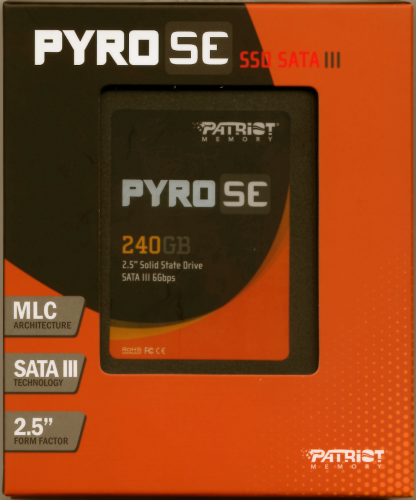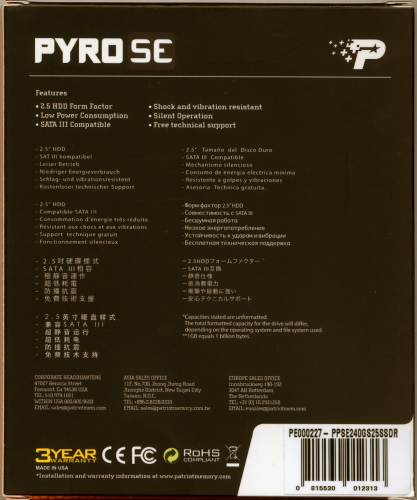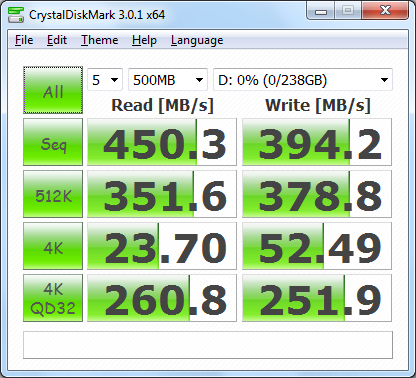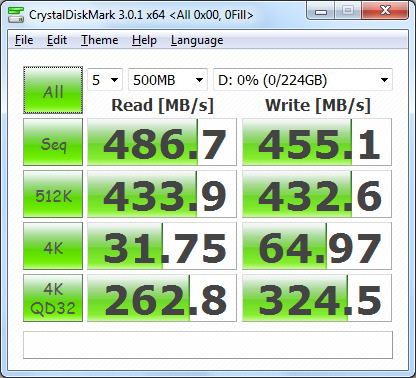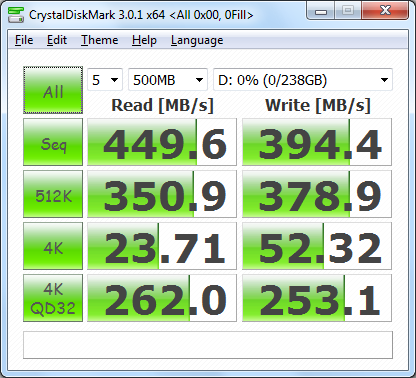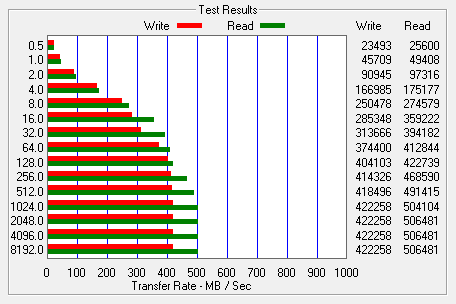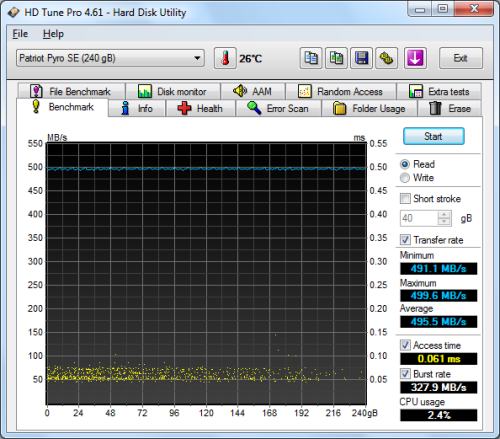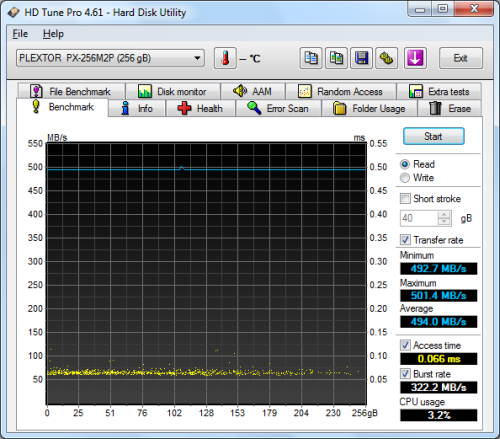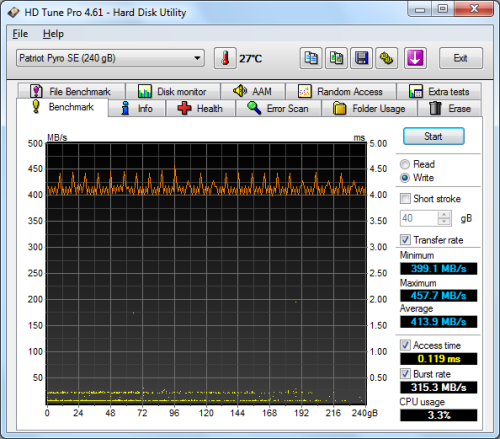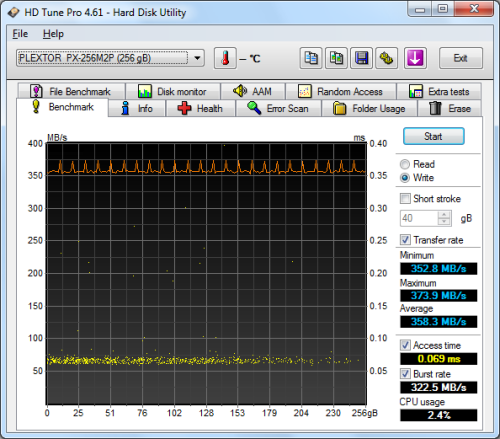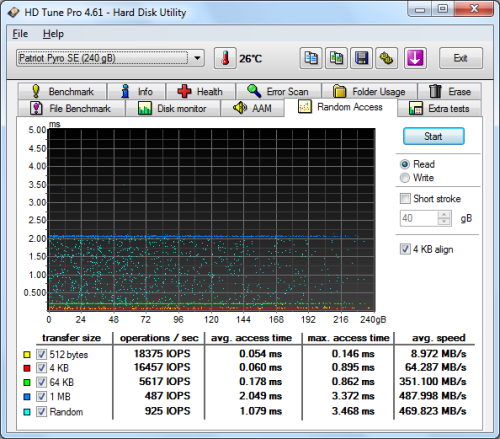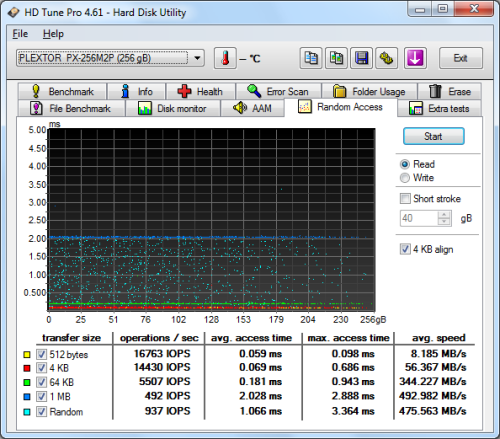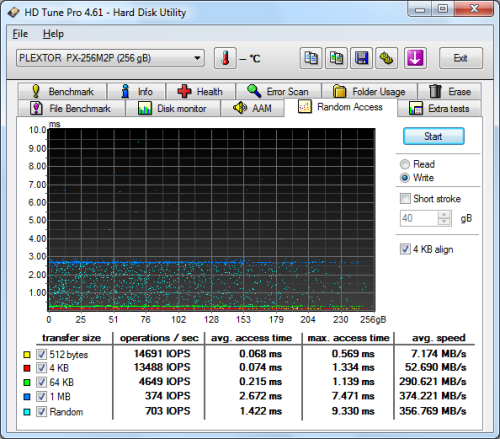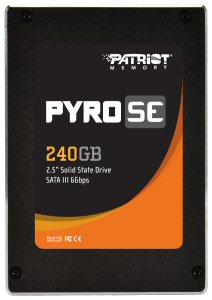

Model: Patriot Pyro SE 240GB Solid State Drive
Manufacturer: Patriot Memory
Provided By: Patriot Memory
Among computer enthusiasts the name Patriot is synonymous with quality and value. Founded in 1985, this California-based company has established itself as a leader in the industry by delivering high quality memory solutions powered by the latest technology. Along with a full range of memory modules for desktops, laptops and servers, Patriot offers an assortment of flash-based data storage products including memory cards, solid state drives (SSDs) and USB flash drives.

This past summer, Patriot introduced its WildFire series of solid state drives. Powered by SandForce's SF-2281 processor, the WildFire offered enterprise-class performance as well as features like a SATA 6GB/s interface and native TRIM support. The drive's only real downside was its use of costly Toggle Mode NAND which put it out of reach for many consumers. Shortly thereafter, Patriot launched its Pyro line of SSDs. This mainstream alternative to the WildFire was based on the same SandForce processor but used asynchronous NAND. This made the Pyro much easier on the wallet but also resulted in some slightly lower performance numbers.
Patriot has now released the Pyro SE. This new and improved version of the Pyro is also powered by SandForce's SF-2281 processor. However, instead of asynchronous NAND, the Pyro SE is equipped with 25nm synchronous MLC NAND to deliver up to 550MB/s read and 520 MB/s write speeds as well as a maximum of 85,000 IOPS. Even with this added performance, Patriot has maintained its aggressive pricing strategy to offer one of the best price-per-performance ratios on the market.
| Patriot Pyro SE 240GB Solid State Drive | |||||||||||||||||||||||||||||||||||||||
General Specifications
Performance
Reliability
Power Consumption
Environmental
Dimensions and Weight
Other Features
|
Needless to say, this is only a taste of what the Pyro SE has to offer. To give you an idea of what to expect, we'll take a closer look at Patriot's new SSD and then see how it compares to some of the drives from the competition. Does the Pyro SE have what it takes? Can it deliver the performance we've come to expect from Patriot? Keep reading as we find out.
The Pyro SE comes in a small, black and orange box. The front advertises many of the drive's key features including its MLC architecture, SATA 6Gbps interface and 2.5-inch form factor. There is also a small, plastic window which lets you look inside the box and see what the Pyro SE looks like. The back of the box provides a bit more information, including a longer list of features.
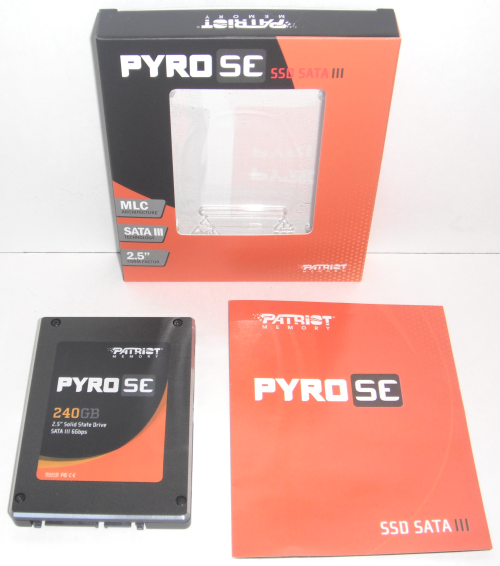
Patriot doesn't include a lot of extras with the Pyro SE. Aside from the SSD, the only other thing in the box is a small, fold out guide that contains a list of specifications as well as installation instructions for both desktop and notebook computers.
Physical Features:
The Pyro SE looks very similar to Patriot's WildFire and Pyro series SSDs. In fact, if it weren't for the large orange and black label on top, it would be very hard to tell them apart. The Pyro SE's outer casing is made out of cast aluminum and is held together using four hex screws. The drive also sports a durable, matte black finish as well as a silver border along the top edges of the case.


As I mentioned earlier, the Pyro SE uses SandForce's SF-2281 controller chip. The SF-2281 can be found in a number of other SSD's including the ADATA S511, Corsair Force Series 3, OWC Mercury 6G, Kingston HyperX and OCZ Vertex 3 as well as Patriot's own Wildfire and Pyro series.


For the 240GB Pyro SE, Patriot opted to use Micron's 16GB 25nm 29F128G08CFAAB synchronous NAND flash chips. Looking at the pictures above, you can see that there are eight of these chips on either side of the PCB. If you do the math, you'll see that this equals 256GB and not the 240GB of storage the drive advertises. The SandForce controller uses this extra 7% (16GB) to maximize read and write performance and extend the endurance and overall reliability of the drive.
The test system used in this review was an HP 8200 Elite. The computer came equipped with an Intel Core i5-2400 CPU, 4GB of DDR3 1333MHz memory, Seagate Barracuda 7200.12 ST3250312AS 250GB SATA 6 Gb/s hard drive, NVIDIA Quadro FX580 512MB PCIe graphics card and an Intel 82579-LM gigabit network card. For the operating system, I installed a fresh copy of Windows 7 Enterprise.
To test the performance of the Pyro SE, I ran a series of benchmarks using CrystalDiskMark 3.0.1, HD Tach RW 3.0.4.0, ATTO Disk Benchmark 2.46, AS SSD, HD Tune Pro 4.61 and Iometer. For comparison, I've also included test results from the Plextor PX-256M2P, Kingston HyperX, OCZ Vertex 3 and OCZ Agility 3.

As I mentioned earlier, the Pyro SE is based on SandForce's SF-2281 controller. Like other SandForce controllers, the SF-2281 features a technology called DuraWrite, which uses data compression to lower write amplification and extend the life of the drive by reducing the number of program-erase cycles. This data compression also plays a big part in the controller's performance. The more the data can be compressed, the faster an SSD like the Pyro SE is able to read and write. Looking at the screenshot above, you can see that there is a considerable performance difference when writing incompressible (0%) and compressible (100%) data. However, thanks to the Pyro SE's synchronous NAND, its read speeds aren't affected nearly as much.
CrystalDiskMark 3.0.1:
First, I ran a few quick tests using CrystalDiskMark. This benchmark tool measures the performance of a storage device by testing its sequential read and write speeds as well as its random read and write speeds using blocks 512K and 4K in size.
According to Patriot, the 240GB Pyro SE is capable of reading at 550MB/s and writing at 520MB/s when connected to a SATA 6 Gb/s port. While faster than the Plextor PX-256M2P when reading, the drive's sequential read and write speeds came up a bit short of these numbers when using CrystalDiskMark's default (random) test data.
The Pyro SE performed much better when using highly compressible 0x00 (0 Fill) data. This time around, the drive was able to read at 486.7 MB/s and write at 455.1 MB/s.
HD Tach RW 3.0.4.0:
Next, I used HD Tach to test the Pyro SE's read, write and burst speeds as well as its seek times and CPU usage.
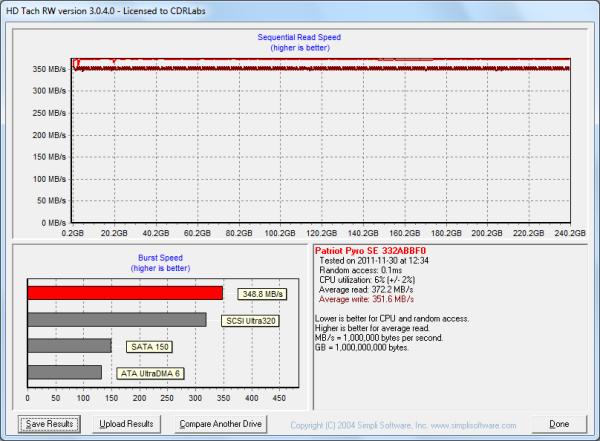
Looking at the screenshot above, you can see that the Pyro SE had average read and write speeds of 372.2 MB/s and 351.6 MB/s respectively, as well as a burst speed of 348.8 MB/s.
ATTO Disk Benchmark 2.46:
I also used ATTO Disk Benchmark to test the Pyro SE's sequential read and write speeds. The tests are run using blocks ranging in size from 0.5KB to 8192KB and the total length set to 256MB.
When tested with ATTO, the Pyro SE's read speeds topped out at about 554 MB/s and its write speeds at 490 MB/s.
AS SSD:
AS SSD is a relatively new benchmark designed specifically for solid state drives. The application contains five synthetic tests used to determine the sequential and random read and write performance of a drive.
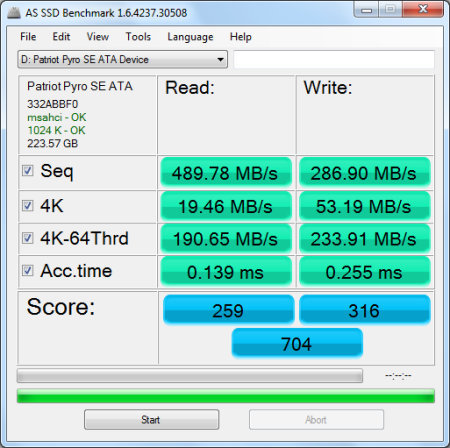
AS SSD also includes a copy benchmark. This test copies an ISO (two large files), program (many small files) and game (small and large files), returning the speed and duration of each.

HD Tune Pro 4.61:
Next, I ran a series of tests using HD Tune Pro. This hard disk utility measures a drive's performance by testing its sequential read and write speeds as well as its access time, burst rate and CPU usage. For this review, I'm also going to use it to benchmark the Pyro SE's random read and write speeds, random access times and the number of operations per second.
The Pyro SE performed very well when benchmarked with HD Tune. The drive had average read and write speeds of 495.5 MB/s and 413.9 MB/s, respectively, and a burst rate of 327.9 MB/s when reading.
The Pyro SE didn't disappoint when doing random reads and writes. When reading 4KB blocks, the drive reached 16457 IOPS and had an average speed of 64.287 MB/s. The Pyro SE was even faster when writing, reaching 19261 IOPS with an average speed of 75.242 MB/s.
Iometer:
Lastly, I ran a series of tests using Iometer. This tool can be configured to benchmark a number of things. In this case, I used it to measure the Pyro SE's read and write speeds and the number of operations per second. The tests were run using random bytes and a queue depth of 3.

The Pyro SE's performance was very similar to what we saw in our other tests. With highly compressible, repeating data, the drive was able to read at 523.8 MB/s and write at 472.74 MB/s. The Pyro SE did not slow nearly as much as the OCZ Agility 3 when reading random data. However, its write speeds dropped to 291.12 MB/s.

The Pyro SE performed very well when doing random reads and writes. With repeating data, the drive was able to read at 65.56 MB/s and write at a blazing 288.52 MB/s. Here too, the Pyro SE took a performance hit when tested with random data. However, it was still able to write at 172.09 MB/s.

According to Patriot, the Pyro SE can deliver a maximum of 85,000 IOPS when randomly writing 4K blocks. In our tests, the drive reached 73,861 IOPS with repeating data and 44,055 IOPS with random data.
TRIM Performance:
While SSDs offer many benefits, there are some downsides to using flash memory. One of the biggest issues people run into is performance degradation. Over time, an SSD will run out of fresh blocks and will have to write over data the file system has marked as deleted. This procedure is very complicated and can slow an SSD's write speeds considerably.
To address this problem, most manufacturers have added TRIM support to their SSDs. The TRIM command allows an operating system, such as Windows 7, to tell an SSD which data blocks are no longer in use. Using this information, the drive pro-actively erases these blocks and adds them to the free block pool.

To test the Pyro SE's TRIM function, I first put the drive in a "dirty" state. I used Iometer to fill the entire drive and then ran a random write test for 30 minutes. Looking at the screenshot below, you can see that the Pyro SE's average read and write speeds dropped to 280.8 MB/s and 212.4 MB/s, respectively.
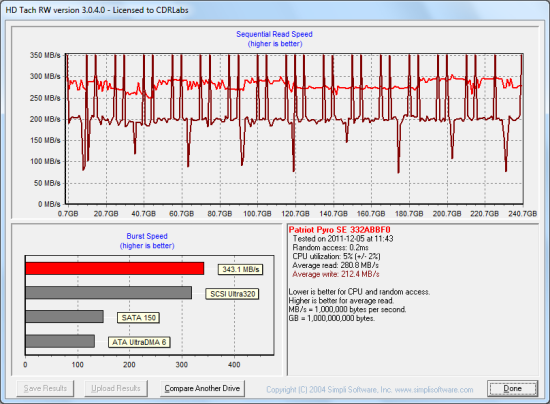
Patriot Pyro SE - Dirty
To see how well the Pyro SE could recover, I let the computer sit for a few hours and then reran the test. The drive's average read speed climbed up to 297.1 MB/s. However, its write speed still lagged a bit behind, averaging out at 266.7 MB/s.
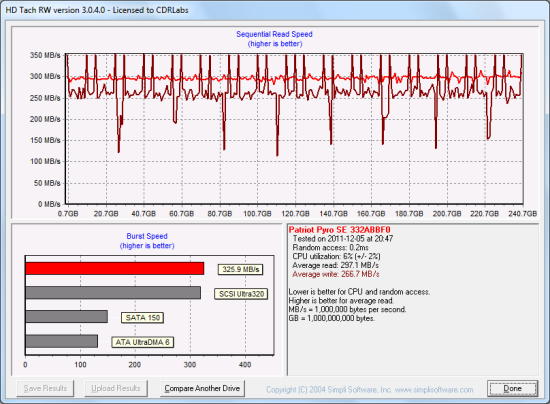
Patriot Pyro SE - After Trim
Lastly, I used Parted Magic to perform a secure erase on the Pyro SE. With the drive wiped clean, its write speed jumped back up to 349.6 MB/s.

Patriot Pyro SE - Wiped
Final Thoughts:
With the Pyro SE, Patriot has filled the performance gap between the high-end WildFire and the budget friendly Pyro. Aimed at performance users and gamers, the Pyro SE combines SandForce's SF-2281 controller with Micron's 25nm synchronous NAND flash. As you saw in our review, this combination produced some impressive performance numbers. In our sequential read and write tests, the drive was able to read at speeds as high as 554 MB/s and write at speeds in excess of 470 MB/s. It also took the top spot in our random write tests, delivering more than 73,000 IOPS. As with other SandForce drives, the Pyro SE's performance did take a hit when reading and writing incompressible data. However, thanks to its synchronous NAND flash, its performance didn't suffer nearly as much as some other drives.
The Pyro SE is available now in 60GB, 120GB and 240GB capacities. Despite its $125 price tag, I have a feeling that most enthusiasts will skip the 60GB Pyro SE in favor of the 120GB and 240GB models. The 120GB Pyro SE currently retails for around $205 on Amazon or for as little as $165 after rebate at places like Newegg. This is a very good price for a 120GB SandForce-based SSD, even when you consider the extra $5-$10 it would cost to buy a desktop bracket. The 240GB Pyro SE currently goes for as little as $410 after rebate, which is in line with the SSDs from the OCZ and Corsair. However, if you look hard enough, you can actually find the 240GB WildFire for less. As usual, we'll leave the choice up to you.

Highs:
- Available in 60GB, 120GB and 240GB capacities
- SandForce SF-2281 processor with DuraClass, DuraWrite and RAISE technologies
- Excellent sequential read and write speeds
- SATA 6Gb/s interface
- Synchronous NAND flash
- Supports TRIM, SMART and NCQ
- Very well constructed
- 3 year warranty
- 60GB and 120GB versions are reasonably priced
Lows:
- Does not include a 2.5" to 3.5" adapter bracket
- Not as fast when writing incompressible data
- 240GB version is still pricey
